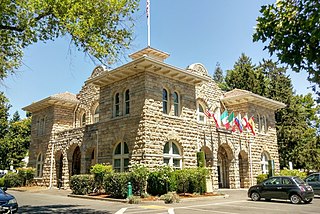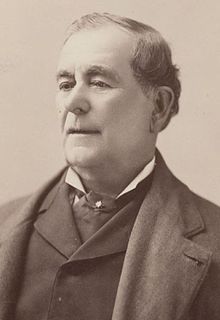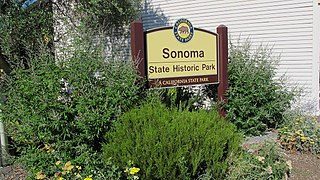
Vallejo is a city in Solano County, California and the second largest city in the North Bay region of the Bay Area. Located on the shores of San Pablo Bay, the city had a population of 126,090 at the 2020 census. Vallejo is home to the California Maritime Academy, Touro University California and Six Flags Discovery Kingdom.

Petaluma is a city in Sonoma County, California, located in the North Bay region of the San Francisco Bay Area. Its population was 59,776 according to the 2020 census.

Sonoma is a city in Sonoma County, California, located in the North Bay region of the San Francisco Bay Area. Sonoma is one of the principal cities of California's Wine Country and the center of the Sonoma Valley AVA. Sonoma's population was 10,739 as of the 2020 census, while the Sonoma urban area had a population of 32,678. Sonoma is a popular tourist destination, owing to its Californian wineries, noted events like the Sonoma International Film Festival, and its historic center.

The California Republic, or Bear Flag Republic, was an unrecognized breakaway state from Mexico, that for 25 days in 1846 militarily controlled an area north of San Francisco, in and around what is now Sonoma County in California.

Don Mariano Guadalupe Vallejo was a Californio general, statesman, and public figure. He was born a subject of Spain, performed his military duties as an officer of the Republic of Mexico, and shaped the transition of Alta California from a territory of Mexico to the U.S. state of California. He served in the first session of the California State Senate. The city of Vallejo, California is named after him, and the nearby city of Benicia is named after his wife.

Philip Seymour Hoffman was an American actor. Known for his distinctive supporting and character roles—typically lowlifes, eccentrics, underdogs, and misfits—he acted in many films and theatrical productions, including leading roles, from the early 1990s until his death in 2014.

Californio is a term used to designate a Hispanic Californian, especially those descended from Spanish and Mexican settlers. California's Spanish-speaking community has resided there since 1683 and is made up of varying Spanish, Mexican, Mestizo, and Indigenous Californian origins. Alongside the Tejanos of Texas and Neomexicanos of New Mexico and Colorado, Californios are part of the larger Chicano/Mexican-American/Hispano community of the United States, which has inhabited the American Southwest and the West Coast since the 16th century.

Nancy Kelsey was a member of the Bartleson–Bidwell Party. She was the first white woman to travel overland from Missouri, seeing Utah and Nevada before crossing the Sierra Nevada mountains into California on November 25, 1841. Wife of Benjamin Kelsey, and the mother of eight surviving children, she is sometimes referred to as the "Betsy Ross of California" for her role in creation of the original Bear Flag from which Bear Flag Rebellion got its name.

Monterey State Historic Park is a historic state park in Monterey, California. It includes part or all of the Monterey Old Town Historic District, a historic district that includes 17 contributing buildings and was declared a National Historic Landmark in 1970. The grounds include California's first theatre, and the Monterey Custom House, where the American flag was first raised over California.

The Suisunes were a Patwin tribe of Wintun people, originating in the Suisin Bay and Suisun Marsh regions of Solano County in Northern California. Their traditional homelands stretched between what is now Suisun City, Vacaville and Putah Creek around 200 years ago. The Suisunes' main village, Yulyul, is believed to be where Rockville, California is located today. Father Abella, visitor to the tribe in 1811, indicated they resided in the present location of Fairfield, north of the Suisun Bay. One of the Suisunes' primary food sources was acorns. Their diet also included fish as well as miner's lettuce. Their huts were conical wikiups made of rushes or tule thatch.
Camilo Ynitia was born in 1803, in Marin County, southern Marin, of the Huiman tribe near Sausalito. They likely traveled up to Olompali, where his father had built an adobe brick home. Camilo was a notable leader of the Coast Miwok, a Native American people. Camilo was known as the last Hoipu (headman) of the Miwok community living at Olompali and the Coast Miwoks of the Southern Marin Band. Camilo was also the only Native American on the northern frontier of Alta California to secure and keep a large Mexican-era land grant: In 1843 Governor Manuel Micheltorena of Alta California deeded him the Rancho Olompali, a large tract of land that is between present-day Novato and Petaluma, California. A part of this land now comprises the Olompali State Historic Park.

Sonoma State Historic Park is a California State Park located in the center of Sonoma, California. The park consists of six sites: the Mission San Francisco Solano, the Sonoma Barracks, the Blue Wing Inn, La Casa Grande, Lachryma Montis, and the Toscano Hotel.

Gustav von Seyffertitz was a German film actor and director. He settled in the United States. He was born in Haimhausen, Bavaria and died in Los Angeles, California, aged 81.
Rancho Mallacomes was a 17,742-acre (71.80 km2) Mexican land grant in present-day Napa County and Sonoma County, California given in 1843 by Governor Manuel Micheltorena to José de los Santos Berreyesa.

Rancho Bodega was a 35,487-acre (143.61 km2) Mexican land grant in present day Sonoma County, California given in 1844 by Governor Manuel Micheltorena to Stephen Smith. Bodega takes its name from the Peruvian explorer Juan Francisco de la Bodega y Quadra who discovered Bodega Bay in 1775. The grant extended along the Pacific coast from the Russian River on the north to Estero Americano on the south, and included the present-day town of Bodega Bay. Only a small part of Bodega is within the grant.
Rancho San Miguel was a 6,663-acre (26.96 km2) Mexican land grant in present-day Sonoma County, California given in 1840 by Governor Juan B. Alvarado to William Marcus West. The grant was located north of present-day Santa Rosa, between Mark West Creek and Santa Rosa Creek, and encompassed present-day Mark West and Mark West Springs.

Rancho Roblar de la Miseria was a 16,887-acre (68.34 km2) Mexican land grant in present-day Sonoma County, California given in 1845 by Governor Pío Pico to Juan Nepomuceno Padilla. "El Roblar de la Miseria" means "The Oak of the Misery". The grant extended along the Petaluma River from Hessel, Roblar, Liberty and Two Rock south to Petaluma.

The Sonoma Barracks is a two-story, wide-balconied, adobe building facing the central plaza of the City of Sonoma, California. It was built by order of Mariano Guadalupe Vallejo to house the Mexican soldiers that had been transferred from the Presidio of San Francisco in 1835. The Presidio Company and their commander, Vallejo, were also responsible for controlling the Native Americans living on the northern border of Mexican California.

The interim government of California existed from soon after the outbreak of the Mexican–American War in mid-1846 until U.S. statehood in September, 1850. There were three distinct phases:

Doña Francisca Benicia Carrillo de Vallejo (1815-1891) was a Californio pioneer. A member of the Carrillo family of California, Carrillo was the wife of Mariano Guadalupe Vallejo. Carrillo was an early settler of Sonoma, California, the town founded by her husband. She survived the Bear Flag Rebellion and went on to oversee the Vallejo estate, Lachryma Montis, until her death in 1891. The city of Benicia, California is named after her.